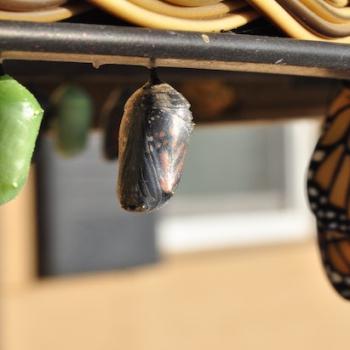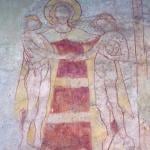St. Dymphna is one of those obscure, nearly forgotten saints who (so far) has never achieved the celebrity status of Catholic heroes such as St. Augustine, St. Thomas Aquinas, St. Catherine of Siena, St. Teresa of Avila, or St. Pope JPII.
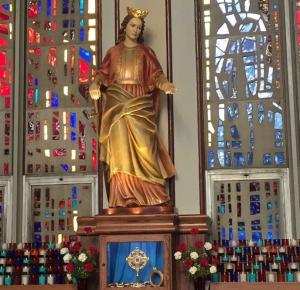
Yet that doesn’t make her any less inspirational, nor does it make her any less of a powerful intercessor when we call upon her in our needs. And, blessedly, her shift from 7th century obscurity to modern-day acknowledgement is beginning to change—and I’m about to tell you why.
Why Do We Need a “New” Patron Saint for Domestic Abuse Survivors?
But first … Why do we need a “new” patron saint to help inspire and strengthen domestic violence survivors, a saint who can also be a friend and companion along the spiritual path toward healing from trauma? Do a quick internet search for the patron saint of abused women, and chances are the two most frequent names you’ll come up with are St. Monica (mother of St. Augustine of Hippo, b. 332 AD, d.381) and St. Rita of Cascia (b. 1381, d. 1457).
Both St. Monica and St. Rita were filled with great piety, outstanding faith, immeasurable patience, and Christ-like charity. Their lives were admirable, their strength enormous. Yet they also lived in a certain time in history when things were … well, different. Spousal abuse was certainly frowned upon by Christians, with many outspoken advocates, such as St. John Chrysostom, who in the 4th century wrote:
The partner of one’s life, the mother of one’s children, the foundation of one’s every joy, one ought never to chain down by fear and menaces, but with love and good temper. For what sort of union is that, where the wife trembles at her husband? And what sort of pleasure will the husband himself enjoy, if he dwells with his wife as with a slave, and not as with a free-woman?
Even so, the life of a domestic abuse victim was necessarily one of silence and endurance. “Put up and shut up”—that was the best a woman could do. She couldn’t leave her situation, unless she was willing to accept abject poverty and societal shunning as a result.
Of his mother, St. Monica, St. Augustine wrote in his Confessions (Book IX):
[My father] was unfaithful to her but her patience was so great that his infidelity never became a cause of quarreling between them … Though he was remarkably kind, he had a hot temper, but my mother knew better than to say or do anything to resist him when he was angry. If his anger was unreasonable, she used to wait until he was calm and composed and then took the opportunity of explaining what she had done.
Unbeknownst to St. Augustine, this is a perfect description of the Dr. Jekyll and Mr. Hyde personality of a domestic abuser, as well as a great description of the abuse cycle.
St Monica’s faith and patience won out, because in the end her husband converted to Christianity and stopped abusing her.
As for St. Rita, she endured her situation until her husband died and she was set free.
While we can admire the strength and faith of St. Monica and St. Rita—two women who managed never to feel discouraged or lose faith even when facing unbearable circumstances—I think it’s time to update the patron saint of abused women.
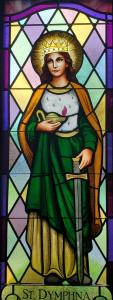
Why St. Dymphna?
St. Dymphna is a 7th century Irish saint. Her pagan father was a minor king of the Oriel (Airgíalla) region of Ireland, and her mother was a faithful Catholic. Due to the child abuse and trauma experienced in her young life, along with the mental illness suffered by her father and the psychological miracles attributed to her, St. Dymphna is now the patron saint of those suffering from emotional and psychological distress, particularly depression, anxiety, and PTSD.
The same issues victims and survivors of domestic violence commonly struggle with.
This is what we know about her young life: St. Dymphna’s mother, Odilla, was not only kind and virtuous, but extremely beautiful. She was one of those fairy-tale queens, “the most beautiful in all the land,” and her daughter Dymphna looked like a delicate, miniature version of her mother. Odilla was also a devout Catholic, and taught her daughter the faith. Damon, on the other hand, remained a firm pagan who ruled his tiny kingdom with iron grit and an unbending will.
At some point in Dymphna’s young life Odilla passed away, leaving Damon distraught and in deep, mind-destroying grief. He was eventually counseled by his advisors to seek another wife, so he told them to travel around Ireland—and even to other countries—to find a woman as beautiful and sweet as his first wife.
Long story short, Damon’s advisors couldn’t find another woman as beautiful as Odilla—except for the teenage Dymphna. Undeterred by the fact that she was his daughter, Damon decided to force Dymphna into marrying him. (The ancient Irish elite had no issue with incest, so perhaps the practice was still in place in the 7th century, among those who remained pagan.)
15-year-old Dymphna was aghast at the idea. Not only had she already consecrated herself to Christ and a life of celibacy, but the idea of marrying her own father was … well, we can all imagine what it was.
Terrified, heartbroken, and realizing an urgent need to escape, Dymphna managed to flee Ireland with her beloved family priest and confessor, Fr. Gerebran. She realized that making this escape would mean giving up the luxury of her station and instead living in poverty, but the material risk was worth it to her.
They found a boat that would take them to Antwerp, Belgium, and from there traveled to the quaint village of Gheel. Making a home in a small hut next to St. Martin of Tours chapel, Fr. Gerebran attended to the spiritual needs of the people while Dymphna attended to the poor as well as those who were ill. It wasn’t merely the physically ill she was given the grace to minister to, but the emotionally ill as well—those filled with anxiety, depression, trauma and turmoil. Through helping them heal, she was able to find healing for her own distraught and anxious soul after enduring the ravages of domestic assault at the hands of her father.
Sign up to Subscribe to Create Soul Space: Stay Updated on the Latest Articles
However, Dymphna and Fr. Gerebran had made one fatal mistake. They’d taken a small bag of Oriel coins with them to sustain their journey, and Damon was able to track his coins and locate his daughter. Pathologically enraged at her escape and refusal to be his daughter-wife, in a jealous fury Damon beheaded Fr. Gerebran. Without her protector, Damon was sure Dymphna would have no choice but to finally marry him.
Yet still she refused to give in to her father’s coercive control and abusive demands, which further enraged him. His insane anger reached such extreme proportions that, in one swift movement, he drew his sword and murdered his own daughter in the same way he had Fr. Gerebran. Her head tumbled to the ground next to that of her beloved confessor.
St. Dymphna was merely 15 years old at the time of her martyrdom.
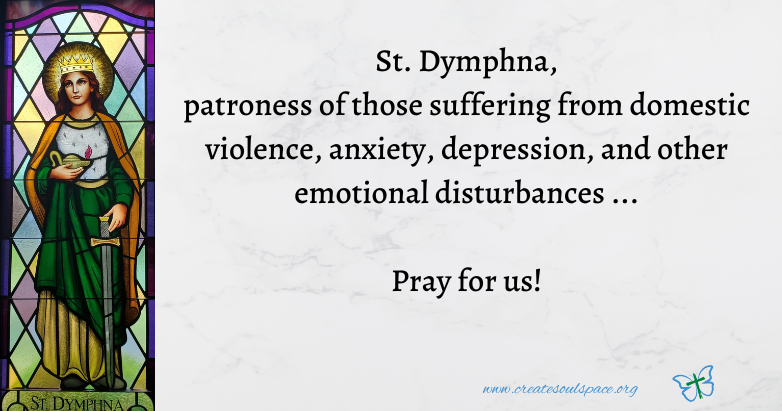
In deep grief and mourning, the good people of Gheel buried Dymphna and Fr. Gerebran in a cave. However, many years later they decided that the two martyrs should have a proper burial, so they opened the cave to remove the bodies for what they thought would be better burial grounds. There they were amazed to find two pure white coffins, pristine and carved by no hands they had ever known. Inside St. Dymphna’s coffin was a red tile with the words, “Here lies the holy virgin and martyr, Dymphna.”
The coffins were placed inside a small church, and a few centuries later a larger church was built to house the holy tombs. Throughout the centuries many verified miracles and cures have been attributed to the intercession of St. Dymphna, leading Pope Eugenius IV to canonize her in 1431.
The miraculous cures attained through the intercession of St. Dymphna have centered on emotional and psychological illnesses, including anxiety disorders, depression, and more. So many miracles have occurred that Gheel is now world-famous for its care of the mentally distressed and those in need of emotional support, help, and healing.
Victims of domestic abuse have been through continued and nearly-constant trauma. Emotional healing after such trauma is a must, and common side-effects of abuse include PTSD, crippling anxiety, panic attacks, isolation (which exacerbates depression), and feelings of hopelessness. Because St. Dymphna experienced her fair share of trauma and abuse at the hands of her father, because she experienced anxiety and overcame it by helping others and, even in death, interceding on behalf of those emotionally suffering, her role as the patron saint of domestic violence survivors seems obvious.
St. Dymphna, pray for us!
St. Dymphna is the patron saint of anxiety, depression, emotional disturbances, and Alzheimer’s Disease. You can visit to the National Shrine of St. Dymphna in Massillon, OH for more information.








